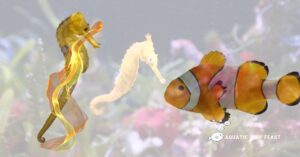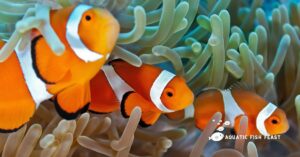How do clownfish eat? Clownfish eat their food using their unique mouth teeth structure to grab on foods, and they primarily eat small invertebrates, plankton, algae, and bits of dead organic matter.
My first experience studying how clownfish eat was when I bought 4 clownfish in my aquarium.
This was some years ago when I was still a teenager. I was curious about how clownfish eat, their behavior, and the foods they dislike.
That is all I will discuss in this article from my vast experience with clownfish.
See what clownfish like to eat
Let’s get started!
Table of Contents
How Do Clownfish Eat Their Food?
Clownfish eat their food using their small mouths to nibble on tiny bits floating in the water. This is quite interesting; I often study them when I feed them.
What they do at first when you drop the food, they will only try to eat food that had sunk in the sea, but most times, when I feed them, they come up to the surface and begin to peck at it.
They are good at eating the following food:
- Plankton
- Small algae
- Other small organisms.
Clownfish are omnivores, meaning that they eat both plants and small animals.
The clown fish that live in the sea get their food from their environment, typically sea anemones with which they have a special relationship.
This closeness of the clownfish and the anemones results from the protection they get from anemones against being hurt by their predators.
And on the other hand, the clownfish feed the anemones by bringing them small food scraps.
So, you can see that clownfish have a clever way of getting their meals and staying safe at the same time, which is cute.
How Much Food Do Clownfish Eat?
How much clownfish should eat determines their size, age, and the kind of food available in their environment.
Clownfish are small fish that only require a little food to sustain themselves. They have relatively small appetites compared to larger fish.
But if you have them in an aquarium, the normal setdown rule is to feed them with small amounts of food at a time.
Fish flakes or pellets are a common food you give them in an aquarium and should be once or twice a day.
I prefer you feed them once a day; they should be well-rested, and you should feed them an amount of food they can consume within a few minutes.
The wild clownfish primarily feed on smaller zooplankton, algae, and detritus. You can see that their feeding depends on natural food sources around where they live.
If you have clownfish in your aquarium, consider how you may monitor their feeding patterns and modify their food to ensure a healthy and balanced diet.
Avoid placing too much food in your aquarium since it could bring about water quality challenges.
How Often Do Clownfish Eat
The clownfish is a generalist omnivorous animal since its diet is animal and vegetable in equal parts, which consumes various foods, such as algae, mollusks, and small crustaceans.
This feeding has a hierarchical structure since the largest and dominant fish move further away from their anemones.
While the smaller ones are exposed to aggression from other fish, others have to feed on what they find close to the safety of their host anemone.
Clownfish are saltwater fish with plenty of room in their stomachs, so everything else doesn’t matter.
But for the ones I have in my aquarium, I often give them food once a day at a fixed time after work.
I give them the amount about the size of the fish’s head, but I am always careful to give it to all the fish in the same amount.
I have my clownfish separate according to their weight and size, which also determines the amount of food I should give them at a particular time.
But the bottom line is that I give them food once every day, and the quantity of food is based on their age, weight, and size.
Feeding Clownfish In An Aquarium
Although the food of clownfish in when are very broad.
But when you want to raise them in an aquarium, you can get used to the same food that you give to them the most.
Clownfish can feed both on dead and live food, and they are very receptive to small crustaceans.
They also eat many specimens and prefer to stay under the lower part of the aquarium. They also eat vegetables that grow around them.
Feeding in the anemone
Apart from protecting its tenant from other larger fish that coexist in the aquarium, the anemone provides it with food.
The clownfish feeds on the food waste and parasites of the anemone. For this reason, a symbiotic coexistence exists between both animal species.
Aside from their usefulness as companions for clownfish, anemones add indescribable beauty to aquariums.
Anemones require very clean water and specific lighting.
How to Care for a Clownfish in the Aquarium
Your clownfish is happy in an aquarium when you replicate its natural habitat to resemble the tropical and salty waters where this species is accustomed to living.
Given its tropical nature, it’s essential to maintain an aquarium with appropriate vegetation and a coral substrate, specifically white sand, which, in reality, is eroded and crushed coral.
Additionally, maintaining the water temperature within the range of 23 to 29ºC is vital.
The aquarium’s size is also critical since each clownfish introduced into the aquarium requires more than 65 liters of water.
Therefore, careful calculations are necessary to house one couple or multiple fish in the same tank.
Clownfish feeding tips
Despite its small size, remember that clownfish are carnivorous predators that enjoy hunting for their food.
They also require a variety of plant matter in their diet.
Food should be offered in a way that does not remain static in the water, triggering their predatory instincts.
In addition to a dry and balanced diet, clownfish can be fed with octopus, cockles, mild-tasting fish, shrimp, mussels, chicken liver, worms, and cooked spinach.
Clownfish behaviors
Clownfish are highly active and benefit from an aquarium with anemones as their constant companions.
This environment keeps them engaged as they focus on maintaining the polyps and ensuring their comfort.
Consequently, they tend to be calmer and less prone to boredom. These fish are territorial but adhere to a hierarchy within their species.
Larger clownfish will gravitate towards larger anemones, while smaller ones will inhabit the smaller ones.
When considering housing clownfish with other species, exercise caution, as although they are typically peaceful, they can become targets for aggression from other fish.
It’s advisable to seek guidance from your local pet store to make informed decisions.
Lastly, an adult must supervise the process in the event of breeding. The eggs must be transferred to a separate aquarium to protect them from being consumed by other fish.
The Anemone And The Clownfish
You should know that anemones are vital for clownfish to enjoy a favorable habitat.
There is a symbiosis between both species that favors their existence. Therefore, you will have one anemone for each clownfish specimen.
These fish are territorial and will fight among themselves if they do not have an anemone for each specimen.
There are many varieties of clownfish, and it is convenient to have the most suitable type of anemone specific for each clownfish.
When you adopt the fish, they should inform you adequately about this circumstance and provide you with the fish and the compatible anemone.
My Final Take
Clownfish require a rich food composed of animal origin and a small proportion of plant matter.
They are omnivorous animals. Sometimes, they can be given live food to eat. In this way, the predatory instinct of the clownfish will be satisfied.
Clownfish are also social fish, communicating through popping and clicking noises.
They live in groups of male fish with one dominant female and a dominant male, along with a small group of smaller males.
Also, when the female fish in the group dies, the dominant male fish will transform to become a female forever, and the biggest of the smaller males will become the next dominant male.
Read also: What fish can eat besides fish food.




